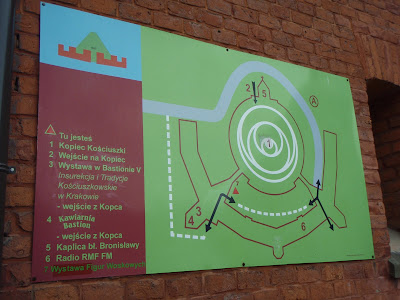Years later I revisited the Polish city and wrote this piece about them for a newspaper. As the article has since vanished from the Web, here it is again for your reading pleasure...
When catching a taxi from the airport into the old medieval heart of Kraków, Poland, I glance up to see a curiously pointed peak to the west. It looks man-made, and so it is.
This enormous 34 metre high earthen mound was erected by volunteers in the 1820s, in honour of the 18th century Polish war hero Tadeusz Kościuszko.
Kościuszko’s name is no stranger to monuments - it appears on streets and landmarks across Poland, where he once led a peasant army to victory against a better armed Russian force; and in the USA, where he was a hero of the War of Independence.
His name was also given to Australia’s highest mountain, courtesy of Polish explorer Count Strzelecki.
The Kościuszko Mound is a fascinating landmark, and not unique. For the attractive historic city is blessed with four such monuments scattered about its suburbs: the Krakus, Wanda, Kościuszko and Piłsudksi Mounds.
The two oldest - Krakus and Wanda - are the most fascinating, simply because so little is known about them. They predate Polish history and it seems they’re not burial mounds, as no remains have been found inside them.
Legends link them with Krakus, the legendary founder of the city, and with Wanda, a queen who sacrificed herself to save her country.
If they were erected as monuments to great leaders, then the Kościuszko Mound is a worthy successor to these ancient predecessors.
It’s visually impressive, sitting atop a hill and encircled by a massive red-brick fortress built in the 1850s by Kraków’s then Austrian rulers (the above photo is of a model of the property). The grassy conical mound, encircled by overlapping trails, is itself held within a circular brick wall liked to a series of bastions facing the city.
As I ascend one of the walking trails up the mound, which curve gently in cobblestone arcs up its slopes, I can see what a prestigious position Kościuszko’s memorial commands.
From the top, there are views that take in forest and the sprawling Błonia, a medieval meadow that’s now a popular recreational space. In the city’s Old Town district is the massive bulk of Wawel Castle, once the home of Polish kings; and in the distance is a suggestion of the enormous communist-era steelworks of Nowa Huta.
Moving from the sublime to the, well, cheesy is the display of waxworks tucked away within two floors in the old fort. They’re arranged in static scenes depicting famous Poles of the past, including Kościuszko himself in consultation with his American commander-in-chief Jerzy Waszyngton (better known as George Washington).
After leaving the war heroes behind, I stroll past various moustachioed literary and political achievers including interwar leader Jozef Piłsudski, who is memorialised by the fourth mound in the nearby Las Wolski woods. Then I under a low arch to discover the late Pope John Paul II stepping out of a cutaway section of an aircraft.
I end my mound visit at the open air cafe located on the ramparts of the fort. It’s set with colourful flower boxes, with the beautiful city laid out below.
With beer in hand, I think of Kościuszko. He may not have finally prevented the 18th century conquest of his country by its neighbours, but he gave it a damn good try; and bequeathed us this fascinating monument.
The Kościuszko Mound is located at Al Waszyngtona 1, Kraków, Poland. For opening hours and entry fees, visit its website.






No comments:
Post a Comment